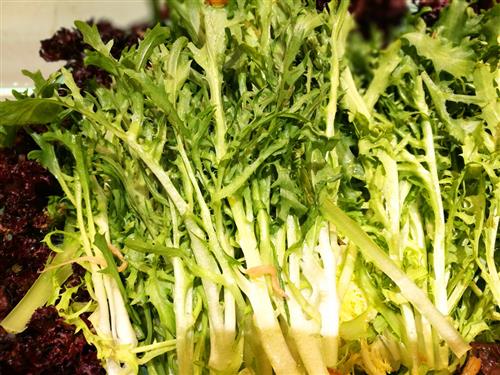Osamu is the 23rd solar term in 24 solar terms. In most parts of our country, the temperature from the “big bonnet†to “big chill†is the lowest in the whole year, “go on the 39th and 49th on the ice†and “big typhoon and big coldâ€. "Frozen as a group" and other folk proverbs describe the cold of this season. Since the winter, everyone has been tonic, at this time can properly eat some cold food to balance.

The main push ingredients: bitter chrysanthemum
Bitter chrysanthemum is a kind of chrysanthemum, also known as bitter vegetables, its cold, bitter taste, can clear away heat and detoxification, stasis swelling, digestion and stomach, cooling blood to stop bleeding.
Therapeutic efficacy: Anti-bacterial, anti-inflammatory and immune
Bitter chrysanthemum contains dandelion sterols, choline, vitamin C and various flavonoids. It has a strong killing effect against Staphylococcus aureus and hemolytic streptococcus, and also has a certain killing effect against Streptococcus pneumoniae and Shigella. , Often eat bitter chrysanthemum can prevent a variety of bacterial or viral infections. Bitter chrysanthemum leaves have a wide range of amino acids and a proper proportion of various amino acids, which can improve human immunity.
Nutritional methods: Do not exceed half a catty daily
There are many ways to eat bitter chrysanthemum, salad, fried, hot pot, etc. are good to eat, but because of its cold, one should not eat too much, usually the maximum daily consumption of 250 grams can be. Eating taboo: Spleen and stomach should not eat more
Bitter chrysanthemum is best eaten by people who get angry. For those who have bad breath or love acne, those who are impatient are also suitable. However, spleen and stomach Deficiency chills warm, not suitable for eating bitter chrysanthemum, otherwise it will increase spleen and stomach symptoms.
Data supplement: Each 100 grams of fresh chrysanthemum contains protein 1.8 grams, carbohydrate 4 grams, dietary fiber 5.8 grams, calcium 120 milligrams, phosphorus 52 milligrams, vitamin C88 milligrams, carotene 3.22 milligrams, including vitamin C and carotene content They are 2.1 and 2.3 times the content of the corresponding substances in spinach. There are also trace elements such as zinc, copper, iron, and manganese.
95.0% OPC Grape seed extract is one kind of Grape Seed Extract which is our Key product. It is a purple powder and was producted by extracting,concentrating and drying;from the seeds of Grape.
The omponents are mainly phenolic acid such as procyanidins,catechin,epicatechin,gallic acid, epigallocatechin gallate and so on.
Grape seed is the seed of grape, after the separation of grape skin, grape stalk product. Grape seed contains amino acid, vitamin and mineral to wait.
Grape seeds contain polyphenols (GPS), mainly catechins and proanthocyanidins.Catechin compounds, including catechin, epicatechin and their gallate esters, are the main monomers of grape seeds and the constituent units of proanthocyanidin oligomers and polymers.
Grape seeds are rich in oil, accounting for about 12% ~ 15% of its weight. Oil contains a lot of unsaturated fatty acids, among which the content of linoleic acid is between 58% ~ 78%.Grape seeds also contain a small amount of volatile components, most of which are alcohols, phenols and terpenoids, all of which have high biological activity.In addition to the above mentioned substances, grape seeds also contain crude protein, amino acids and vitamins A, E, D, K, P and A variety of trace elements, such as calcium, zinc, iron, magnesium, copper, potassium, sodium, manganese, cobalt and so on.
The omponents are mainly phenolic acid such as procyanidins,catechin,epicatechin,gallic acid, epigallocatechin gallate and so on.
Grape seed is the seed of grape, after the separation of grape skin, grape stalk product. Grape seed contains amino acid, vitamin and mineral to wait.
Grape seeds contain polyphenols (GPS), mainly catechins and proanthocyanidins.Catechin compounds, including catechin, epicatechin and their gallate esters, are the main monomers of grape seeds and the constituent units of proanthocyanidin oligomers and polymers.
Grape seeds are rich in oil, accounting for about 12% ~ 15% of its weight. Oil contains a lot of unsaturated fatty acids, among which the content of linoleic acid is between 58% ~ 78%.Grape seeds also contain a small amount of volatile components, most of which are alcohols, phenols and terpenoids, all of which have high biological activity.In addition to the above mentioned substances, grape seeds also contain crude protein, amino acids and vitamins A, E, D, K, P and A variety of trace elements, such as calcium, zinc, iron, magnesium, copper, potassium, sodium, manganese, cobalt and so on.
Grape Seed Extract,Grape Seed Extract Powder,Nature Grape Seed Extract,95% Grape Seed Extract
Shaanxi Kepler Biotech Co.,Ltd , https://www.keplerherb.com